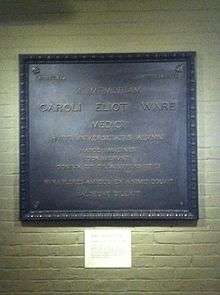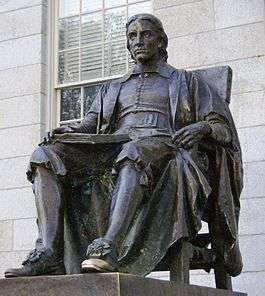Charles Eliot Ware

Charles Eliot Ware (May 7, 1814 – September 3, 1887)[1] was a prominent Boston physician[2] and the husband of Elizabeth Cabot Lee, their daughter being Mary Lee Ware. It is to him that the Harvard Museum of Natural History's famous Glass Flowers exhibit is dedicated to as a memorial, his wife and daughter being the sponsors of the project.[3]
Family life

Son of Henry Ware (1764–1845), Dr. Charles Eliot Ware married the wealthy Elizabeth Cabot Lee (from then on Elizabeth C. Ware) and, in 1858, their daughter Mary was born in the town of Rindge, New Hampshire (reports/sources vary regarding the existence, with the bare majority suggesting it, of Dr. Charles Eliot Ware having an older son named Charles Jr). While not a botanist himself, Dr. Ware and his wife raised Mary to love botany with a passion and live according to the precept "It is more blessed to give than to receive,"[4] taking her to Italy as young girl and nurturing her love of beauty both natural and human made (i.e. picturesque landscape and the arts). Then, in 1868, Charles E. Ware bought what would become the Ware Farm in Ware Farm from a Joseph Davis and Dorestos Armory for $3000 – the place having 450 total acres, 21.5 dedicated to pasture land with another 56.5 for cultivation.[5] This farm would serve as his wife and daughter's later home and would always stand out happily among Mary's childhood memories.[4]
Seasonal residents (and farmers) of Rindge, Charles Eliot Ware and his family also kept a home at Boston, 41 Brimmer Street (Back Bay) and, eventually, they would send their daughter to Radcliffe College where she learned under Professor George Lincoln Goodale[6][7] - who would become the first director of the Harvard Botanical Museum. In fact, "Mary Ware, an especially fascinating character, became in many respects a professional naturalist," a role which she was later able to utilize by being the patron sponsor of the Glass Flowers, her purpose being to advance the education of women.[8]
Medical career
Harvard class of 1834, Charles Eliot Ware received a Doctor of Medicine degree three years later in 1837 and founded a large private practice which he actively maintained for years until his health began to fail him.[9] For the next decade Dr. Ware served as "one of the visiting physicians to the Massachusetts General Hospital, and on his resignation, in 1867, was appointed on the Consulting Staff."[9] In 1842, Ware, along with Dr. Samuel Parkman, founded the New England Quarterly Journal of Medicine, but the journal was canceled due to lack of support after a single year.
Occupying such other leading roles as a member of the Board of Trustees - and Vice-President - of the Boston Lying-in Hospital and Secretary of the Massachusetts Medical Society, Charles E. Ware was described as "well fitted for his calling by the clearness of his perceptions, by the soundness of his judgment, and by his industrious habits. He was well read in medical literature, and, while not departing from a wise conservatism, his mind was open to receive the new truths which are constantly presented by the rapid advance of medical science."[9] As such, Dr. Charles Ware was also a member of the Boston Society for Medical Improvement, an elite medical society based in Boston, Massachusetts established for the purposes of "the cultivation of confidence and good feeling between members of the profession; the eliciting and imparting of information upon the different branches of medical science; and the establishment of a Museum and Library of Pathological Anatomy"[10] At some point he was also a professor at Harvard Medical School.
Upon his retirement, Dr. Ware continued his and his family's seasonal residency and cultivation of the Ware Farm and, on September 3, 1887, Charles Eliot Ware died in said farm - leaving it to his wife and daughter.[11]
The Glass Flowers


Ironically, the good Doctor's legacy and reputation as a nature-lover was established after his death by his grieving family. The "ever-loyal and ever-generous"[7] Mary Lee Ware and her Elizabeth C. Ware, Dr. Ware's widow, were drawn into the Glass Flowers enterprise in 1886 when her former teacher, Professor George Goodale, approached them with his idea to populate the new Botanical Museum (of which he was the first director) with uncannily lifelike glass botanical specimens made by a German father and son team of lampworkers - Leopold and Rudolf Blaschka.[12] Being independently wealthy and (already) liberal benefactors of Harvard's botany department,[13] Mary convinced Mrs. Elizabeth C. Ware to agree to underwrite the consignment,[14] but this was done anonymously at first (and would remain so until 1888).[15] A year later, 1887, Charles E. Ware died, thus when the official contract was signed between the Mary and her mother, Leopold and Rudolf, and Harvard, the agreement was that the collection would be a memorial to the now deceased Doctor: "The first Blaschka glass flowers are formally presented to the Botanical Museum as a memorial to Dr. Charles Eliot Ware, Class of 1834, by his widow Elizabeth C. Ware and daughter Mary L. Ware."[3][15][16] Today, there is a large bronze plaque in the exhibit's center formally dedicating it to the nature-loving Doctor, father, and husband.
Other indirect legacies

In addition, the Ware Farm remains in active use today. "In 2002 Steve and Beverly Lindell purchased the property, resurrected the Ware Farm name, and have since tended and cherished the property in a manner complimentary to its heritage: original buildings are lovingly preserved; the flower gardens are spellbinding and constantly abuzz with pollinators; horses roam and graze the pastures; it's forest is managed in conservation through the Monadnock Conservancy. The farm presently consists of 230 acres, the majority on the east side of Woodbound Road, matching closely the original Ware Farm footprint."[17] Today the farm is the home-base of HOOF&CLAW - a training and consultation center for dog handling and horsemanship - as well as the home of Blaine Capone, HOOF&CLAW's founder.[18] Mr. Capone, in turn, continues to honor the legacy and philanthropic spirit of the Wares (specifically mentioning Mary), insofar as their deep love of nature went, working with HOOF&CLAW to preserve the environment and inspire solutions to environmental issues.
At some point Dr. Charles Eliot Ware acquired Robert Salmon's The British Fleet Forming a Line off Algiers, which he later left to Mary who, in turn, bequeathed the painting to the Museum of Fine Arts (MFA) in Boston, Massachusetts.[2][19] How Dr. Ware originally obtained the piece, however, remains unknown.
Finally, Charles Eliot Ware's only confirmed child, Miss Mary Lee Ware, would grow up to become a leading philanthropist and farmer of West Rindge, NH - her contributions reflecting the nature-loving and moral lesson impressed upon her by her parents.
External links
References
- ↑ http://www.ancestry.com/genealogy/records/charles-eliot-ware_8748165
- 1 2 http://www.mfa.org/collections/object/the-british-fleet-forming-a-line-off-algiers-32602
- 1 2 "This month in Harvard history". Harvard University Gazette. The President and Fellows of Harvard College. Retrieved 14 January 2016.
- 1 2 Hale, Emily. Mary Lee Ware. Boston, 1937. Print.
- ↑ Harvard University Herbaria and Botany Libraries
- ↑ Rossi-Wilcox, Susan M., and David Whitehouse. Drawing upon Nature: Studies for the Blaschkas' Glass Models. Corning, NY: Corning Museum of Glass, 2007. Print.
- 1 2 Daston, Lorraine. Things That Talk: Object Lessons from Art and Science. New York: Zone, 2004. Print.
- ↑ Making Harvard’s Glass Flowers: the interface of Botany Gender and Artistic Virtuosity in America. A thesis presented by Rupal Christine Pinto, Harvard University Cambridge MA, March 2002 quoting Susan Rossi Wilcox et al “Conservation Survey” Appendix
- 1 2 3 Proceedings of the American Academy of Arts and Sciences, Volume 23 - https://archive.org/stream/jstor-20021531/20021531_djvu.txt
- ↑ Constitution and By-Laws of the Boston Society for Medical Improvement, With a List of Members. Boston: John Wilson & Son. 1853. p. 5. Retrieved 21 September 2014.
- ↑ "Charles Eliot Ware". Proceedings of the American Academy of Arts and Sciences. 23 (2): 346–347. May 1888. JSTOR 20021531.
- ↑ Flowers Out of Glass - http://news.psu.edu/story/140881/1999/09/01/research/flowers-out-glass
- ↑ Flowers that never fade / Franklin Baldwin Wiley. Boston Bradlee Whidden, Publisher 1897
- ↑ Memoirs of the National Academy of Sciences Vol XXI (PDF). Washington, D.C.: United States Government Printing Office. 1927. Retrieved 14 January 2016.
- 1 2 The American Journal of Science, 1895, page 243 - http://www.warefamilies.org/2012/03/mrs-elizabeth-c-ware/
- ↑ Reports of the President and the Treasurer of Harvard College. Harvard University. 1920–1921. p. 5717. Retrieved 14 January 2016.
- ↑ http://www.hoofandclaw.org/ware/
- ↑ http://www.hoofandclaw.org/about/#bio
- ↑ http://www.davidrumsey.com/amica/amico887359-17785.html
